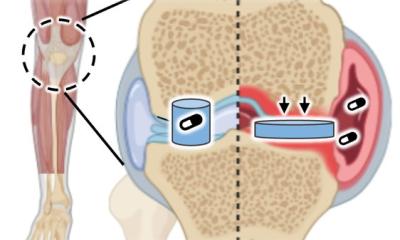News • Osteoarthritis research
New treatment target could halt knee cartilage degeneration
There is currently no cure for osteoarthritis, but a group of scientists believe they’ve discovered a method through which a simple knee injection could potentially stop the disease’s effects.
These researchers showed that they could target a specific protein pathway in mice, put it into overdrive and halt cartilage degeneration over time. Building on that finding, they were able to show that treating mice with surgery-induced knee cartilage degeneration through the same pathway via the state of the art of nanomedicine could dramatically reduce the cartilage degeneration and knee pain. These findings were published in Science Translational Medicine.

Image source: Shutterstock/Xray Computer
“Our lab is one of the few in the world studying epidermal growth factor receptor (EGFR) signaling in cartilage and, from the beginning, we have found that EGFR deficiency or inactivation accelerates osteoarthritis progression in mice,” said Ling Qin, PhD, an associate professor of Orthopaedic Surgery. “Thus, we proposed that its activation could be used to treat osteoarthritis, and in this study, we’ve proven for the first time that over-activating it inside the knee blocks the progression of osteoarthritis.” Qin explained that tests from the other labs that do work with EGFR have drawn “confusing and controversial” results. But Qin’s lab has consistently found the ties between osteoarthritis and EGFR deficiencies, which formed the bedrock of their hypothesis.
The researchers compared typical mice with those that had a molecule that bound to EGFR, called a ligand, that was over-overexpressed in chondrocytes, the building blocks of cartilage. This overexpression drives the over-activation of EGFR signaling in knee cartilage. When examining them, the mice with overexpressed HBEGF (the EGFR ligand) were found to consistently have enlarged cartilage, meaning that it wasn’t wearing away like the mice who had normal EGFR activity. Moreover, when these mice aged to adulthood, their cartilage was resistant to degeneration and other hallmarks of osteoarthritis, even if their knee’s meniscus was damaged. To further prove that the over-activated EGFR was the reason for the mice’s resiliency, the researchers found that gefitinib treatments, which are designed to block EFGR function, took away the protection against cartilage degeneration.
Recommended article

News • Regeneration vs. osteoarthritis
Regrow cartilage in joints? Science says you can
Contrary to popular belief, cartilage in human joints can repair itself through a process similar to that used by creatures such as salamanders and zebrafish to regenerate limbs, researchers at Duke Health found. This process could be harnessed as a treatment for osteoarthritis. Publishing in the journal Science Advances, the researchers identified a new mechanism for cartilage repair.
With all of this knowledge gained, the researchers turned an eye toward potential clinical treatment solutions. In a new series of tests they created nanotherapeutics by attaching a potent EGFR ligand, transforming growth factor-alpha, onto synthetic nanoparticles, to inject into mice who already had cartilage damage in their knees. “Free EGFR ligands have a short half-life and cannot be retained inside of a joint capsule due to their small size,” explained Zhiliang Cheng, PhD, a research associate professor in Penn Engineering and another of the co-corresponding authors on the paper. “Nanoparticles help to protect them from degradation, restrict them within the joint, reduce off-target toxicity, and carry them deep inside dense cartilage to reach chondrocytes.”
The ability to stop or slow the course of osteoarthritis with an injection rather than surgery would dramatically change how we feel and function as we age and after injury
Jaimo Ahn
When mice were injected with these nanotherapeutics, the researchers saw that they slowed cartilage degeneration and bone hardening, as well as eased knee pain. There also were no major side effects seen in the mice who were treated. “While many of the technical aspects of this application still need to be worked out, the ability to stop or slow the course of osteoarthritis with an injection rather than surgery would dramatically change how we feel and function as we age and after injury,” said one of the study’s co- authors, Jaimo Ahn, MD, PhD, a former faculty member at Penn Medicine now chief of orthopaedic trauma and associate chair of orthopaedic surgery at the University of Michigan.
The treatment is likely some time away for human patients, but the nanoparticles used have already been clinically tested and deemed safe, which makes it easier to quickly translate to clinical use. “There is a great unmet medical need for a disease-modifying osteoarthritis drug,” Qin said. “In the future, we will optimize the drug design and test it in large animals before proceeding to clinical trials. We hope our research could lead to a novel drug that will improve the health and well-being of the more than 27 million osteoarthritis patients in the United States.”
Source: University of Pennsylvania/Penn Medicine
18.01.2021










